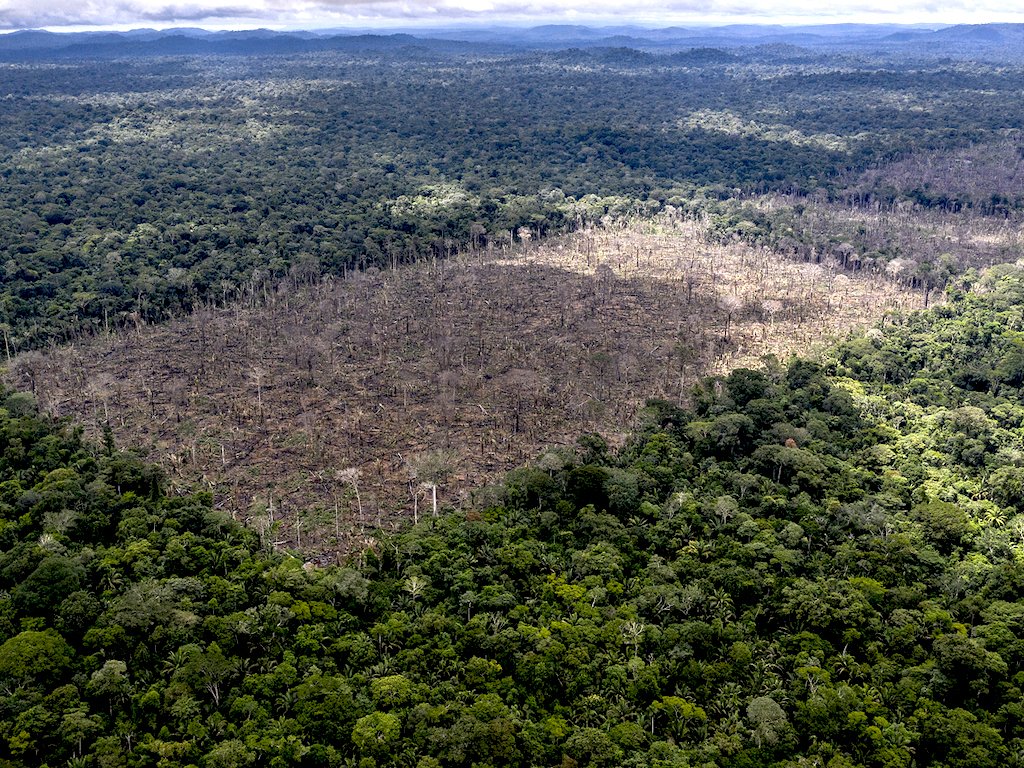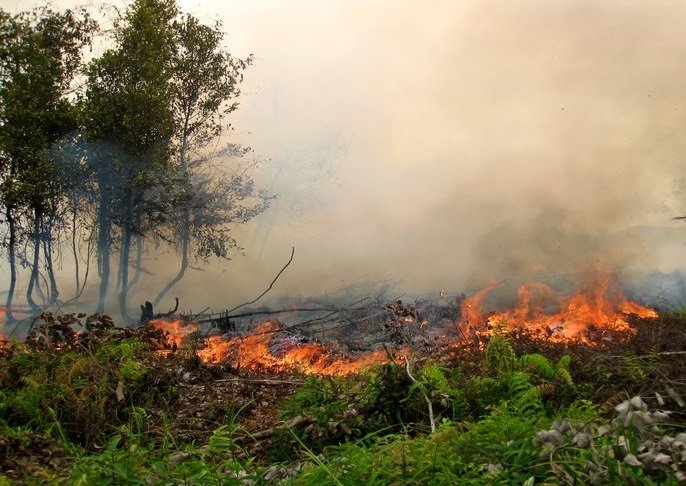Here Is Exactly How Cocoa Farming Is Causing Deforestation
Sustainability in the chocolate market starts with the protection of the environment where cocoa grows.
Only when cocoa grows in protected, nurtured and biodiverse lands, the chocolate we consume can be considered sustainable. This is because, in this idyllic scenario, cocoa becomes part of a virtuous cycle that contributes to the richness of the soil, air cleaning, a thriving wildlife and a more reliable income for the people who grow it. Unfortunately, instead of a virtuous cycle, cocoa is currently trapped in the vicious cycle of deforestation. Let’s understand why.
The cacao tree is not a disruptive plant. Sure it’s needy, delicate, moody and promiscuous, but it’s not invasive, hostile or aggressive. It doesn’t eat up other plants, poison animals or cause damage to its surroundings. Actually, the cacao tree is an amazing plant for the environment: it grows best in the shade of other trees, therefore thriving in biodiversity, and stores a significantly high amount of carbon.
So why is cocoa often considered responsible for deforestation?
How is cocoa farming causing deforestation?
Deforestation is the act of clearing a specific area from all its current plants and trees to make space for non-forest uses like farming, ranching or urban use. Whenever you read about cocoa deforestation, this refers to the lands of rainforest that are intentionally wiped out to plant cacao trees for an intensive and high-productive farming. Wildlife is entirely replaced to profit from cacao.
Pressure to Produce More COCOA
The global cocoa and chocolate market size is projected to grow from $48 billion in 2022 to $67 billion by 2029. Chocolate consumption hasn’t stopped one bit in the past decades, causing the demand for cocoa to grow higher by the day. Cacao farmers, especially in large cocoa producing countries like Ivory Coast and Ghana, are pressured to increase their output. Therefore, they implement farming practices that aren’t always environmentally friendly and sustainable in the long term.
The hunger for chocolate is staying high in Europe and the USA, and it’s only growing in emerging markets like China and India. To supply all these sweet tooth, big chocolate manufacturers push cacao farmers to prioritize quantity over quality. Chocolate consumers aren’t used to seeing chocolate as a fine food and expect to pay extremely cheap prices for it. So the majority of farmers aren’t incentivized to care about fine flavor qualities, but focus on putting together the largest possible volumes to earn a decent income. This is why monoculture, land clearing and illegal farming are common practices in the cocoa sector.
A piece of land in the Amazon Rainforest deforested in Brazil.
Monoculture
When only one crop is cultivated in an area, that’s called monoculture. The farmer focuses on one single produce at a time, so there are no other plants interfering with its growth. The skills are sharpened and the efforts are dedicated to increasing the output of that particular crop as much as possible. Monoculture has been a common practice in the cultivation of cacao, especially in African countries. If on one side this method offers advantages in the short term, its consequences compound in disruptive effects for the environment over time.
Advantages of Monoculture
High Productivity in the short term. Thanks to dealing with only one kind of crop, farmers can implement more efficient strategies than if they were to grow different produces at a time. They can better monitor and manage a land with only one type of crop, and even apply some kind of technology where possible. Plus, their expertise and know-how become deeply specialized and their skills well refined. There are direct (although short-term) advantages also for the cocoa tree that doesn’t have to fight with other plants for soil nutrients, water and sunlight. This absence of competition means that the plant has all the resources for itself. All these elements combined together contribute to a higher productivity compared to polyculture.
Reduced costs. When farmers specialize on one single crop, they continuously use the same material, know-how and technology. This makes their job increasingly less costly and more efficient. As they face the same problems over and over for the same plant, they can solve them with tried and true solutions. Growing more plants at a time would mean developing a different set of skills and tools for each plant, therefore making farming more complex and diversed.
Disadvantages of Monoculture
Need for more pesticides, fertilizers and water. The more depleted the soil gets, the more farmers try to counterbalance this loss with fertilizers. At the same time, the cocoa trees become more vulnerable to pests and diseases: as there are no other plants that act as natural barriers, no shade and too much sun can exhaust the tree and make it weaker and more prone to being attacked by fungus. Even in this case, farmers counterbalance the weakness of the trees with an abundant use of pesticides. Monocultures also need more water input than polycultures: different plants (with different rooting depths) can access more soil moisture compared to the roots of a single plant that can only access moisture on one depth level.
Low productivity in the long term. Biodiversity is what keeps the soil and its nutrients in balance. Without biodiversity (the presence of different plants and wildlife), the soil becomes unbalanced, gets depleted faster, loses its nutrients and dries up. Temperatures and humidity levels also stop being naturally well-regulated. Pollinators are weakened and killed by the environment contaminated with pesticides. This is why monoculture becomes less productive in the long term.
Unstable income for farmers. With monocultures, farmers can only rely on a single crop for their income. They become even more vulnerable to weather conditions and exposed to any price fluctuation in the commodity market. If the seasonal weather isn’t favorable or the price of cocoa suddenly drops, the entire farmer’s income will be in danger. If farmers decided to grow different crops instead, the diversification will make their income more stable and less vulnerable.
We could compare monoculture to hustle culture. Surely you can work intensely all day for several months, fueled by a lot stimulants, sleep-deprived and with bad eating habits because you are so focused on producing as much as possible. But you will eventually burn out and find yourself exhausted. But what happens when the soil gets completely depleted and the harvest isn’t as fruitful anymore? Farmers decide to find the next land to deforest.
Slash and Burn Technique
Because monoculture causes the soil to dry out, farmers can decide to abandon the current infertile land and move to a new one. To start a new monoculture farming, they will use the slash and burn technique: wild or forested land is clear cut and any remaining vegetation is burned. This method creates new plots of land where dense vegetation wouldn’t have allowed farming otherwise. The layer of ash is also known to provide the soil with new nutrients that help fertilize the crop. However, it won’t be long before these nutrients are used up and this method will start showing its downsides.
The slash and burn technique is directly responsible for:
deforestation
desertification
erosion
biodiversity loss
water contamination
landslide
loss of habitat and species
air pollution
Farmers that use this technique can only sustain themselves for about 1 to 2 years before the soil becomes completely infertile and gets abandoned. It’s also this practice that helped decimate protected forests in West Africa.
Vegetation is being burned down to create a new plot of land for farming.
Illegal Cocoa Plantations Inside Protected Areas
Ivory Coast has lost about 85% of its forest cover since 1960, mostly because of cocoa farming. Not only this, but 40% of Ivorian cocoa is coming from illegal plantations inside protected areas. Landless people living below the poverty line enter protected areas, clear out pieces of land and start growing cocoa.
Forest reserves, natural parks and protected areas, which are supposed to remain untouched, have now entire communities of farmers living in there. It is a complex problem, as forcibly evicting all occupants won’t resolve much: they will find another land or return soon after to the land that they were evicted from. We are talking about people that are trying to find ways to survive and have nothing to lose.
This is where a lot of untraceable cacao comes from. These illicit farms sell cacao to nearby cooperatives that mix their cacao with the one sourced from legit farms. The collected cacao is then sold to traders, importers and cocoa manufacturers that might or might not be aware of the mixing.
A SELF-PerpetuatING Cycle
Deforestation has become a vicious cycle that repeats itself over and over again. If monoculture is the preferred farming practice, more and more land is used up and depleted over time for highest productivity. When the slash and burn technique and illegal cocoa farming are added to the mix, we are presented with a scary scenario for the environment: hectares upon hectares of land are left infertile, dried up and depleted, while wild animals are forced to move away and biodiversity is increasingly lost in favor of profit.
What once was a flourishing, vibrant and prosperous forest made of diverse fauna and flora, becomes a land that is abused and exploited until there is nothing left to use. This is how cocoa farming is causing deforestation.
Can we stop the cocoa deforestation cycle?
It’s clear how these practices are unsustainable and disruptive in the long term. Here are just some of the root causes of these practices:
the biggest cocoa buyers aren’t willing to pay more for cocoa that is grown sustainably (despite all their greenwashing). These companies are only looking for the highest quantities of cocoa to satisfy the demand of their consumers. Therefore, cocoa farmers aren’t incentivized to put extra effort into more sustainable farming practices.
farmers in rural areas have limited access to the best knowledge and tools for sustainable farming practices (like agroforestry) that preserve the environment and also benefit them in the long run. Therefore, they do what they can to survive with what they know and have at their disposal, most often at the expenses of mother nature.
consumers expect chocolate to come at extremely cheap prices. This drives companies to be uncaring of sustainable farming practices and only look at the highest profit margins from a product that is already sold at a low price tag.
Cocoa deforestation is a vicious cycle indeed, but there is hope. Regenerative farming practices like agroforestry are becoming increasingly popular in the cocoa sector, together with consumer’s awareness of what a fair price for chocolate should look like. The biggest chocolate manufacturers are also being called out for their greediness for profit and are pressured to do more for the environment, starting from more transparency of their supply chain.
Will these efforts be enough to turn cocoa from the environmental villain to the hero of biodiversity?













